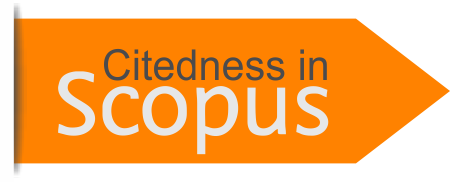Accreditation and Certificate
Submissions
Author Guidelines
Please read and understand the author guidelines for the preparation manuscript. The author who submits a manuscript to the editors should comply with the author's guidelines and template. If the submitted manuscript does not comply with the guidelines or uses a different format, it will be rejected by the editorial team before being reviewed. The editorial team will only accept a manuscript that meets the specified formatting requirements (downloadable at Template and Author Guidelines). This template is designed to assist Author in preparing the manuscript; it is an exact representation of the format expected by the editor. To use this template, please just Save As this MS Word file to your document, then copy and paste your document here. All papers submitted to the journal should be written in English and Indonesian language.
Paper Format
- Manuscripts must be in English. It should be typed in MS Word doc. format; using 10-pt Palatino Linotype font; left, right, top, and bottom margins are 2,5 cm; 1 spaced on A4-sized paper; length: between 4,000 and 8,000 words (including abstract, references, and footnotes).
- The article structure contains (a) Title; (b) Author(s) name, affiliation, and email address of the corresponding author; (c) Abstract; (d) Keywords; (e) Introduction); (f) Method; (g) Findings and Discussion; (h) Conclusion); (i) References, and (n) Appendices (if any).
- The articles were sent using English-Indonesian transliteration according to SKB 3 Ministers.
- The citations and references should follow the style of the American Psychological Association (APA) style and arranged from A to Z and use Reference Management Software such as Mendeley (https://www.mendeley.com).
- The manuscript must be checked in terms of grammar, structure, spelling, etc. It is suggested to use Grammar Checker SoftwareGrammarly (http://app.grammarly.com).
- The manuscript must be submitted through the OJS (Jurnal Ilmiah Ekotrans & Erudisi website).
Title
The paper title should indicate the novelty of the research. It should be concise and informative. It does not contain infrequently-used abbreviations. The main idea should be first written and followed by its explanation. Use bold for your article title, with an initial capital letter for proper nouns with Palatino Linotype, 20pt, bold.
Author(s) name, affiliation, and email address of the corresponding author
The author's name, affiliation, and email address of the corresponding author must not be written in the paper, just put them in the user profile on the journal website. It is suggested as well to remove all document properties and personal information from your file. (The corresponding author will handle correspondence at all stages of refereeing and publication, also post-publication; this responsibility includes answering any future queries about the Methodology and Materials of the paper). Ensure that the e-mail address is given and that contact details are kept up to date by the Corresponding Author.
Abstract
Write down here your paper abstract in one paragraph, in the Italic style of font in 8pt Palatino Linotype. The abstract should stand alone, which means that no citation in the abstract. The abstract should concisely inform the reader of the manuscript’s purpose, its methods, its findings, and its value. The abstract should be relatively nontechnical, yet clear enough for an informed reader to understand the manuscript’s contribution. The manuscript’s title, but neither the author’s name nor other identification designations, should appear on the abstract page. An abstract between 100-200 words. (8pt, single line spacing, 1 paragraph)
Keywords
The keywords should avoid general and plural terms and multiple concepts. Do not use words or terms in the title as keywords. These keywords will be used for indexing purposes. Keywords should not consist of more than five words or phrases, and they should be arranged in alphabetical order, separated by semicolons (;) (8pt)
Introduction
What is the purpose of the study? Why are you conducting the study? The main section of an article should start with an introductory section, which provides more details about the paper’s purposes, motivation, research methods, and findings. The introduction should be relatively nontechnical, yet clear enough for an informed reader to understand the manuscript’s contribution. (10pt, Single line spacing)
Literature Review
The literature review represents previous research in the research topic discussed and also the theoretical core of an article. The purpose of a literature review is to “look again” (re + view) at what other researchers have done regarding a specific topic (Leedy & Ormrod, 2005, p. 70). A literature review is a means to an end, namely to provide background to and serve as motivation for the objectives and hypotheses that guide one’s own research (Perry et al., 2003, p. 660). A good literature review should not merely provide a summary of previous relevant research; the researcher is also expected to critically evaluate, re-organize and synthesize the work of others (Leedy & Ormrod, 2005, p. 84). It must Identify knowledge gaps found by the author when conducting a literature review and build a theoretical explanation that answers the research questions and objectives.
Method
The research methods should elaborate on the method utilized in addressing the issues including the method of analysis. Research methods consist of: data topology, data collection method, data analysis, and data visualization. It should contain enough details allowing the reader to evaluate the appropriateness of methods as well as the reliability and validity of findings.
Findings and Discussion
Includes a description of the findings of the work that discusses sharply (What/How), its relationship with previous concepts/theories (Why), compares critically with the work of others, and strengthens or corrects previous findings (What else).
Conclusion
Answer the research objectives and collect new findings supported by sufficient research data, accurately and in-depth (only one paragraph).
References
Every source cited in the body of the article should appear in the References, and all sources appearing in the References should be cited in the body of the article. The references should be more up-to-date (published in the last 10 years). The primary sources cited in your paper are in the forms of journal articles, proceedings, and research reports including theses and dissertations that can be accessed online (show the permalink/DOI). Citations from journal articles should be at least 80% of the total references cited. The References should be presented alphabetically and chronologically and be set to 11-pt Palatino Linotype font, justified, with single line spacing and hanging indent. Check each reference against the original source (author name, volume, issue, year, permalink/DOI number). Use Reference Management Software such as Mendeley (https://www.mendeley.com), to manage the references for your paper. Use other published articles in the same journal as models.
Submission Preparation Checklist
All submissions must meet the following requirements.
- This submission meets the requirements outlined in the Author Guidelines.
- This submission has not been previously published, nor is it before another journal for consideration.
- All references have been checked for accuracy and completeness.
- All tables and figures have been numbered and labeled.
- Permission has been obtained to publish all photos, datasets and other material provided with this submission.
Articles
Section default policyPrivacy Statement
The names and email addresses entered in this journal site will be used exclusively for the stated purposes of this journal and will not be made available for any other purpose or to any other party.



































